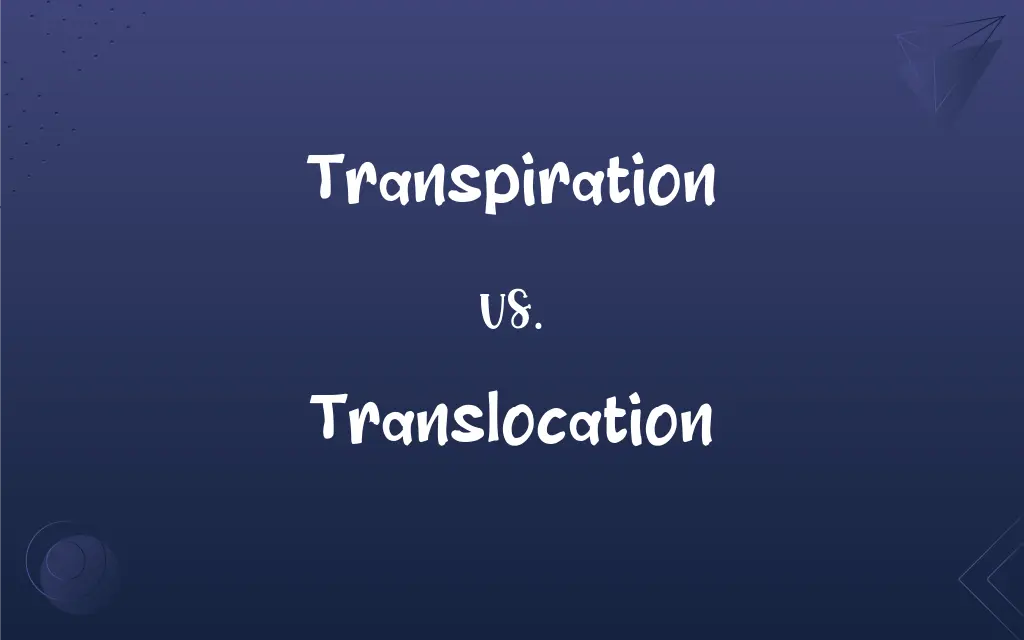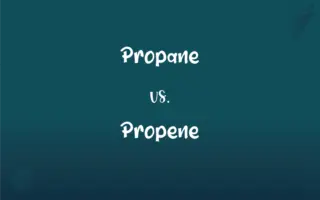Transpiration vs. Translocation: What's the Difference?
Edited by Aimie Carlson || By Harlon Moss || Updated on October 20, 2023
Transpiration is the evaporation of water from plants; translocation is the movement of nutrients within the plant.

Key Differences
Transpiration and translocation are vital processes in plants, but they serve different functions. Transpiration pertains to the movement of water from the roots to the leaves, where it evaporates into the atmosphere. On the other hand, translocation involves the transport of nutrients, primarily sugars, from the leaves (where they are produced) to other parts of the plant.
Regarding the mechanism, transpiration primarily occurs through tiny openings in the leaves called stomata. As water evaporates, it creates a negative pressure, pulling water from the roots upwards. In contrast, translocation operates through the plant's vascular system, specifically the phloem, transferring nutrients to where they are needed, be it for growth, storage, or energy.
While both transpiration and translocation are continuous processes, they exhibit varying patterns. Transpiration rates can change based on external factors such as humidity, light, and temperature. Translocation, however, is influenced more by the plant's internal needs, ensuring nutrients reach areas of growth or storage.
It's essential to appreciate that while both processes are interconnected, they are distinct in their roles. Transpiration aids in nutrient uptake from the soil, thanks to the negative pressure created, facilitating translocation. Yet, translocation ensures the plant's overall health by distributing essential sugars and nutrients to all parts.
Comparison Chart
Primary Function
Evaporation of water from plants
Movement of nutrients within the plant
ADVERTISEMENT
Mechanism
Through stomata in leaves
Through the phloem
Major Components
Water
Sugars and nutrients
Influencing Factors
Humidity, light, temperature
Plant's internal nutrient needs
Role in Plant Health
Helps in nutrient uptake from soil
Ensures nutrient distribution for growth and storage
Transpiration and Translocation Definitions
Transpiration
Water movement from roots to aerial parts.
The majority of water absorbed by roots is lost through transpiration.
ADVERTISEMENT
Translocation
The transport of nutrients in plants.
Translocation ensures that roots receive sugars produced in the leaves.
Transpiration
The loss of water vapor from plants.
Transpiration helps in cooling the plant during hot days.
Translocation
Primarily occurs through the phloem.
Phloem plays a crucial role in translocation, moving nutrients to all parts of the plant.
Transpiration
A process mainly through leaf stomata.
Stomatal openings regulate the rate of transpiration.
Translocation
Distributes photosynthesis products.
Translocation takes sugars from leaves to areas of storage or growth.
Transpiration
The evaporation process from plant surfaces.
Transpiration rates increase with higher sunlight.
Translocation
Governed by plant's internal needs.
Translocation prioritizes nutrient delivery to growing regions.
Transpiration
Influenced by external environmental factors.
On humid days, the transpiration rate tends to decrease.
Translocation
Movement of solutes within the plant.
Translocation is essential for the plant's overall growth and development.
Transpiration
The act or process of transpiring, especially through the stomata of plant tissue or the pores of the skin.
Translocation
A change of location.
FAQs
What is the main role of transpiration in plants?
Transpiration helps in nutrient uptake and cools the plant.
What's the primary medium for translocation?
Translocation primarily occurs through the phloem.
Does cutting leaves reduce a plant's transpiration?
Yes, fewer leaves mean reduced surface area for transpiration.
How does translocation benefit a plant?
Translocation distributes essential nutrients to different plant parts, aiding growth.
Can transpiration affect a plant's health?
Yes, excessive transpiration can lead to water stress.
Is translocation faster during the day or night?
It varies but is often continuous, depending on the plant's internal needs.
What are the primary substances moved during translocation?
Mainly sugars, along with other nutrients.
How does photosynthesis relate to translocation?
Photosynthesis produces sugars, which are then distributed via translocation.
What would happen if transpiration stopped in a plant?
It could lead to reduced nutrient uptake and potential overheating of the plant.
How do guard cells regulate transpiration?
They control the opening and closing of stomata, thereby influencing transpiration.
Can external factors affect transpiration?
Yes, factors like humidity, light, and temperature influence transpiration rates.
Does transpiration only happen during the day?
Mostly, as it's higher when stomata are open, typically during daylight.
Can translocation move nutrients upwards and downwards in a plant?
Yes, translocation distributes nutrients both to the roots and aerial parts.
Why is translocation essential for fruits and seeds?
It delivers necessary sugars and nutrients, aiding their growth and maturation.
How does translocation support a plant during dormancy?
It helps store nutrients in roots or stems for future growth.
What connects transpiration and translocation in a plant?
Transpiration's negative pressure aids in pulling nutrients up, facilitating translocation.
Can pests or diseases affect translocation?
Yes, pests or diseases damaging the phloem can hinder translocation.
Is transpiration solely a plant's loss?
Not entirely. While water is lost, it aids nutrient uptake and cooling.
Can we visually observe transpiration?
Not directly, but its effects, like leaf cooling or soil drying, can be observed.
How does soil moisture affect transpiration?
Adequate soil moisture ensures optimal transpiration, while dry soil can reduce it.
About Author
Written by
Harlon MossHarlon is a seasoned quality moderator and accomplished content writer for Difference Wiki. An alumnus of the prestigious University of California, he earned his degree in Computer Science. Leveraging his academic background, Harlon brings a meticulous and informed perspective to his work, ensuring content accuracy and excellence.
Edited by
Aimie CarlsonAimie Carlson, holding a master's degree in English literature, is a fervent English language enthusiast. She lends her writing talents to Difference Wiki, a prominent website that specializes in comparisons, offering readers insightful analyses that both captivate and inform.































































